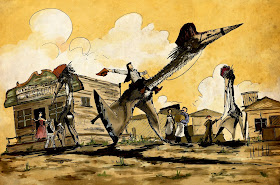Way back at the end of 2009 I illustrated the image above, showing the size range of everyone's favourite rhamphorhynchine pterosaur,
Rhamphorhynchus. This animal was first discoverd in the 1830s and is now represented by over 100 specimens, making it one of the best known pterosaurs, and probably the best known non-pterodactyloid pterosaur, of all. Being represented by specimens with wingspans ranging from 290 mm (in very young juveniles) to 1850 mm in large (probable) adults means that we have a better idea of
Rhamphorhynchus growth allometries than we do for most pterosaurs (Bennett 1995; though also see Prondvai et al. 2012 for a contrary opinion), and this includes a detailed picture of the proportional changes taking place in the skull. These are the focus of this image here, which shows a portrait of a particularly tiny
Rhamphorhynchus specimen with a 30 mm long skull (NHMUK R37012), alongside the biggest with its 192 mm skull length (NHMUK R38077). Unusually among reptiles,
Rhamphorhynchus does not seem to gain more teeth with age, despite the elongation of its jaw presenting space for additional teeth. Instead, the teeth become more robust, transforming from fine, needle-like structures to relatively short, tusk-like forms. The shape of the mandible also becomes more pronounced with age, developing a curving, pointed keel. The orbits - predictably - decrease in relative size, but adult
Rhamphorhynchus retain proportionally large eye sockets even as adults, which probably hint at their predatory leanings.
This image was the first time I largely excluded showing details of the cranial fenestra in my reconstructed animals. They're still visible, but I recall making a very conscious decision to mute their appearance. Nowadays, my illustrations don't show them at all. Those interested in palaeoart will be aware that there is currently a real push against the classic 'shrink-wrapped' appearance of animals in palaeoart, defying generations of artists who have applied minimal amounts of soft-tissue to their reconstructions to show their osteological details (check out Matt Wedel's festive
plea for healthy-looking sauropods for an example. From
this SV:POW! post). The observation that most skeletal anatomy is hidden behind soft-tissue is the rationale behind this movement, and it may be one of the most significant paradigm shifts to the palaeoart of Mesozoic and Palaeozoic reptiles since palaeontologists of the late 1960s and 1970s told artists to lift their dinosaur tails off the floor. More on this movement another time, perhaps: this is meant to be a word-light blog, after all.
References
- Bennett, S. C. 1995. A statistical study of Rhamphorhynchus from the Solnhofen Limestone of Germany: year-classes of a single large species. Journal of Paleontology, 69, 569-580.
- Prondvai, E., Stein, K., Ősi, A. and Sander, M. P. 2012. Life history of Rhamphorhynchus inferred from bone histology and the diversity of pterosaurian growth strategies. PLoS ONE, 7, e31392.



